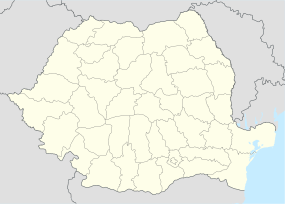Histria (Sinoe)
| Ἰστρίη (Ancient Greek) | |

Panorama of the site
|
|
| Alternate name | Istros |
|---|---|
| Location | Istria, Constanța, Romania |
| Region | Dobruja |
| Coordinates | 44°32′51″N 28°46′29″E / 44.54750°N 28.77472°ECoordinates: 44°32′51″N 28°46′29″E / 44.54750°N 28.77472°E |
| Type | fortified city, settlement |
| Area | 82 ha |
| History | |
| Founded | mid-7th century BC |
| Abandoned | mid-7th century AD |
| Site notes | |
| Excavation dates | 1868, 1914-1915,1925-1927, 1928–1942, 1949–1970, 1971-1990, 1991-2010, 2010- |
| Archaeologists | Ernest Desjardins, Vasile Pârvan, Scarlat Lambrino, Marcelle Lambrino, Emil Condurachi, Dionisie Pippidi, Petre Alexandrescu, Alexandru Suceveanu, Al. Avram, Mircea Angelescu |
| Condition | Ruined |
| Ownership | Public |
| Public access | Yes |
Histria or Istros (Ancient Greek: Ἰστρίη, Thracian river god, Danube), was a Greek colony or polis (πόλις, city) near the mouths of the Danube (known as Ister in Ancient Greek), on the western coast of the Black Sea. Histria is derived from the Latin word "Hister", meaning "Danube", the river the city was located near, and "-ia", a suffix added to a word to signify that it was a location or place, as in Gallia or Iberia. Altogether Histria means "On the Danube", "Located near (or by) - The Danube". It was the first urban settlement on Romanian territory when founded by Milesian settlers in the 7th century BC. It was under Roman rule from the 1st to 3rd centuries AD. Invasions during the 7th century AD rendered it indefensible, and the city was abandoned.
Established by Milesian settlers in order to facilitate trade with the native Getae, it is considered the oldest urban settlement on Romanian territory. Scymnus of Chios (ca 110 BC), dated its founding to 630 BC, while Eusebius of Caesarea set it during the time of the 33rd Olympic Games (657 – 656 BC). The earliest documented currency on Romanian territory was an 8-gram silver drachma, issued by the city around 480 BC.
Archaeological evidence seems to confirm that all trade with the interior followed the foundation of Histria. Traders reached the interior via Histria and the Danube valley, demonstrated by finds of Attic black-figure pottery, coins, ornamental objects, an Ionian lebes and many fragments of amphoras. Amphoras have been found in great quantity at Histria, some imported but some local. Local pottery was produced following establishment of the colony and certainly before the mid-6th century. During the archaic and classical periods, when Histria flourished, it was situated near fertile arable land. It served as a port of trade soon after its establishment, with fishing and agriculture as additional sources of income. By 100 AD, however, fishing had become the main source of Istrian revenue.
...
Wikipedia

